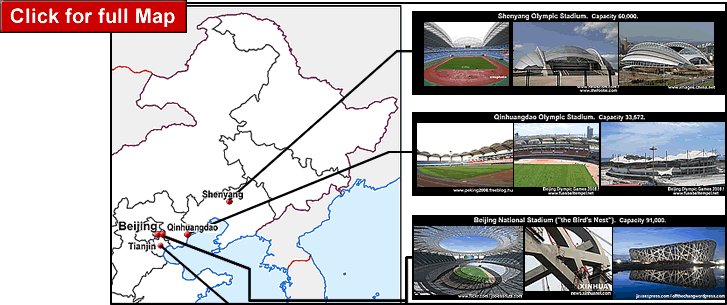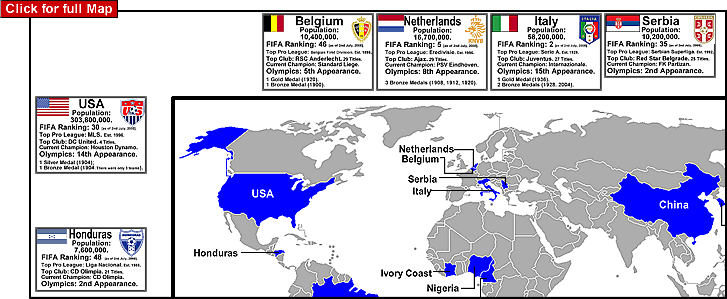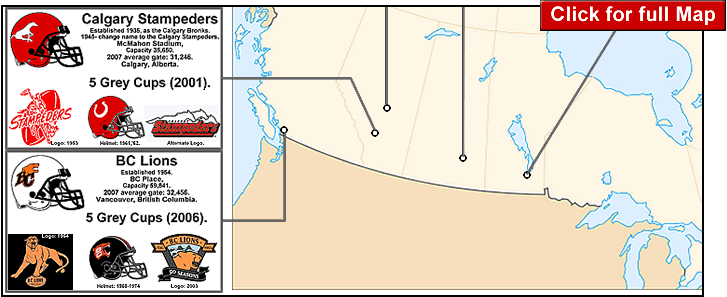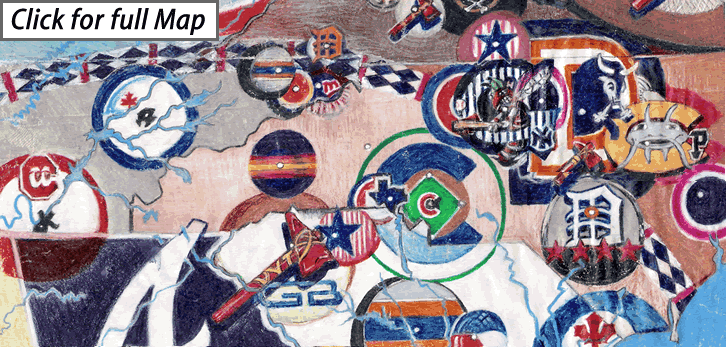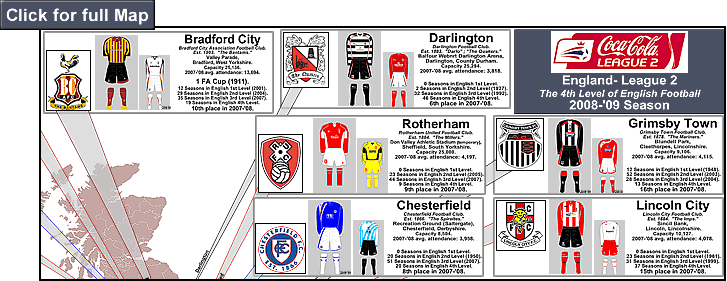
…
…
Note: to see my most recent post on the English 4th division, click on the following: category: Eng-4th Level/League 2.
…
The map shows all 24 clubs in this season’s League Two, which is the fourth Level of the English Football pyramid.
As a whole, League Two averaged 4,337 spectators per game last season, up 4.8 % from 2006-’07 {See this, from the European Football Statistics site}. But much of that increase can be attributed to Bradford City, who, when faced with relegation to League Two last year, slashed ticket prices across the board (they ended up increasing their average gate by 5,000 per game: from 8,694 to 13,694).
Last season was an extremely competitive one, for the clubs outside the dominant top two of MK Dons and Peterborough United. In 2007-08, there were an amazing 208 away wins, compared to only 220 home wins. {See this, from the English Football [Dot] Info site.}
This season sees both promoted clubs from the Conference (ie, the Blue Square Premier League, the 5th Level) from the southern part of England.
Exeter City has had a long history in the Football League, over 75 seasons worth, and have recovered from their recent near financial collapse and dissolution. They won the Conference playoff last May, over Cambridge City. Exeter City has maintained a solid fan base for a club that had been banished to non-League status. The Grecians drew 3,705 per game last season; second highest in the Conference (behind only Oxford United), and drew better than 10 clubs in the Football League.
Aldershot Town is a relatively new entity, which has risen from the ashes of the defunct Aldershot FC (as depicted by their phoenix-bird logo), and 16 years later, have made it into the Football League. They won the Conference handily, and boast a small, but rabid fan base {See this, from last November, on the Pitch Invasion site}. The club may have some tough times ahead this season, but the stands will be jumping.
{Click here, for the odds-makers’ favorites for promotion in League Two this (Statto.com site).} As of 27th July, the bookies are picking Bradford City, Darlington, Gillingham, and Shrewsbury Town to be promoted. Chesterfield, Wycombe, and Rochdale are the next favorites.
Both clubs promoted from the Conference last year were newcomers to the Football League: North Lancashire’s Morecambe, and East London club Dagenham & Redbridge. Both survived. Morecambe did exremely well, with 16 wins, and an 11th place finish. The Shrimps’ average gate went up from 1,598 in the Conference, in ’06-’07, to 2,855 last season. Dagenham looked to be in a relegation battle, before finding safety through two consecutive wins to end the season. The Daggers finished in 20th place, and saw their average gate go from 1,756 to just 2,021 (second lowest in all the 92-club League, higher only than Accrington Stanley).
All four of the clubs relegated from the 3rd Level, League One, in May 2008, have spent most of their seasons above the 4th Level. Luton Town have notched 16 seasons in the top flight, and even won the 1988 League Cup. They have spent their most seasons (34) in the 2nd Level, and before their financial problems, the Hatters, under Mike Newell, in 2005-’06, were actually in the running for a shot at the Premier League. Every thing went pear-shaped fast, and the former board is in disgrace, for their financial improprieties. A new management team has come aboard, but not until after a fatal points deduction which sealed their relegation. And what’s worse is that more points will be deducted for the up-coming season. The same goes for Bournemouth, who put up a valiant eleventh-hour attempt at avoiding off the drop, but to no avail. Port Vale will be in the 4th Level for the first time in 23 seasons. Finally, there is Gillingham, who have spent 55 seasons in the 3rd Level, and as recently as 2005, were in the 2nd Level. But the club from Kent have their own set of money problems, and were unable to afford the caliber of player that would have kept them in League One. The club has a decent size fan base, though (6,077 avg. gate last season).
Here is a very recent article from the Soccer Lens site, by Gary Andrews, about the points-deduction holes that Luton Town, Bournemouth, and Rotherham United find themselves in…{Click Here.}
Thanks to the Historical Football Kits site {click here}, for the kits on the map, which are copyright Historical Football Kits, and reproduced by permission [note: I have indicated on the map which kits are new for this season].


